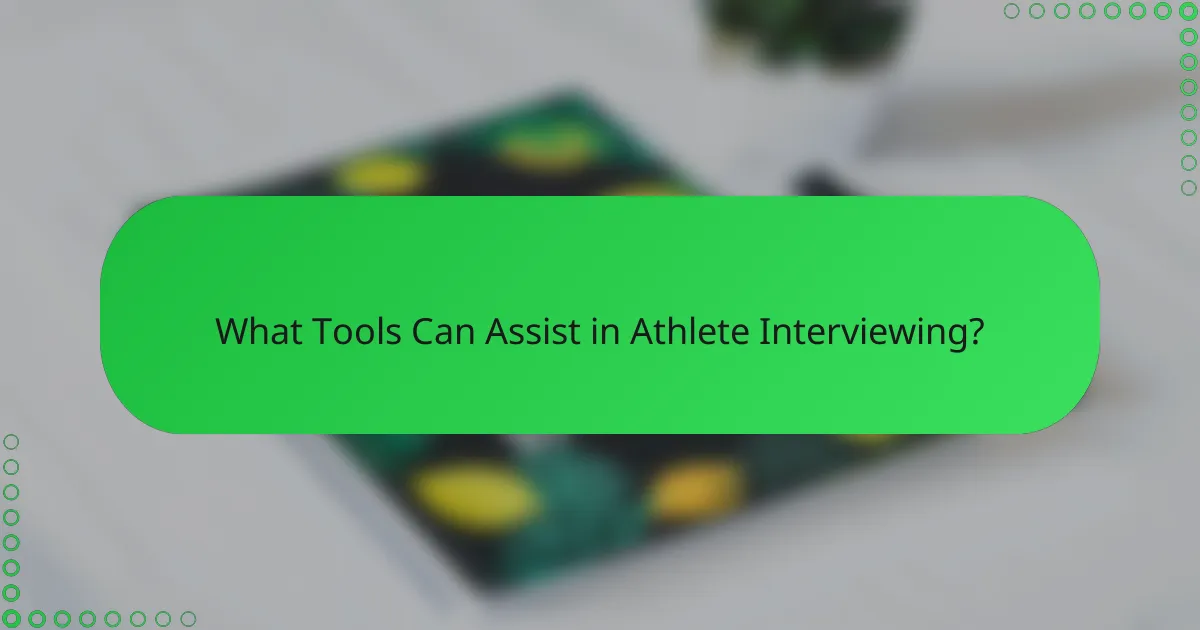Interviewing athletes requires a thoughtful approach that combines effective techniques and strategies to foster open communication. By asking open-ended questions, actively listening, and creating a comfortable atmosphere, interviewers can encourage athletes to share their experiences and insights. Tailoring questions and employing storytelling techniques further enhance the depth and engagement of the conversation.

What Techniques Are Effective for Interviewing Athletes?
Effective techniques for interviewing athletes include asking open-ended questions, actively listening, building rapport, using follow-up questions, and being aware of non-verbal cues. These strategies help elicit detailed responses and create a comfortable environment for the athlete to share their thoughts and experiences.
Open-ended questions
Open-ended questions encourage athletes to elaborate on their thoughts and feelings, providing richer insights. Instead of asking yes or no questions, frame inquiries that start with “how,” “what,” or “why.” For example, instead of asking, “Did you enjoy the game?” you might ask, “What was your experience during the game?”
This approach not only yields more informative responses but also allows athletes to express themselves freely, leading to a more engaging conversation.
Active listening
Active listening involves fully concentrating on the athlete’s words, understanding their message, and responding thoughtfully. This technique requires maintaining eye contact, nodding, and using verbal affirmations like “I see” or “That’s interesting.” Such engagement shows the athlete that their perspective is valued.
By practicing active listening, interviewers can pick up on subtle cues and emotions, which may lead to deeper discussions and insights.
Building rapport
Building rapport with athletes is crucial for creating a comfortable interview atmosphere. Start by establishing a friendly tone and finding common ground, whether through shared interests or experiences. A relaxed environment encourages athletes to open up and share more personal stories.
Simple gestures, such as using the athlete’s name and showing genuine interest in their journey, can significantly enhance the connection and trust between the interviewer and the athlete.
Using follow-up questions
Follow-up questions are essential for digging deeper into the athlete’s responses. After an athlete shares a thought, ask for clarification or elaboration to gain more context. For instance, if an athlete mentions a challenging moment, you could ask, “What did you learn from that experience?”
This technique not only demonstrates your interest but also allows for a more comprehensive understanding of the athlete’s perspective.
Non-verbal cues
Non-verbal cues, such as body language and facial expressions, play a significant role in communication. Pay attention to the athlete’s posture, gestures, and eye contact, as these can reveal their comfort level and emotional state. For example, crossed arms may indicate defensiveness, while open posture suggests openness.
Being aware of these cues can help interviewers adjust their approach, ensuring that the conversation remains positive and productive.

What Strategies Enhance Athlete Interviews?
Effective athlete interviews rely on strategic preparation, a comfortable atmosphere, tailored questions, and storytelling techniques. These strategies help elicit deeper insights and create engaging narratives that resonate with audiences.
Preparation and research
Thorough preparation is crucial for conducting insightful athlete interviews. Research the athlete’s background, recent performances, and any relevant news to formulate informed questions. This knowledge not only demonstrates respect but also allows for more meaningful dialogue.
Consider reviewing previous interviews or articles about the athlete to identify themes or topics that resonate with them. This can help you craft questions that provoke thoughtful responses, making the interview more engaging for both the athlete and the audience.
Creating a comfortable environment
A comfortable environment is essential for encouraging open communication during interviews. Choose a quiet location free from distractions, where the athlete feels at ease. This could be a private room, a cozy café, or even a familiar training facility.
Establish rapport early by engaging in casual conversation before diving into the interview. This helps to build trust and makes the athlete more likely to share personal stories and insights, enriching the overall quality of the interview.
Tailoring questions to the athlete
Tailoring questions specifically to the athlete’s experiences and personality can significantly enhance the interview’s depth. Avoid generic questions; instead, focus on their unique journey, challenges, and achievements. This personalization encourages athletes to share their authentic selves.
Consider using open-ended questions that allow for expansive answers, rather than simple yes or no responses. For example, instead of asking, “Did you enjoy the last game?”, you could ask, “What were your thoughts on the last game and how it impacted your season?”
Utilizing storytelling techniques
Incorporating storytelling techniques can transform an athlete’s interview into a compelling narrative. Encourage athletes to share anecdotes that illustrate their experiences, challenges, and triumphs. This approach not only captivates the audience but also humanizes the athlete.
Use prompts that guide the athlete to elaborate on specific moments or emotions. Questions like, “Can you describe a pivotal moment in your career?” or “What motivates you during tough times?” can elicit powerful stories that resonate with listeners and readers alike.

How Can Interviewers Overcome Common Challenges?
Interviewers can effectively navigate common challenges by employing specific techniques tailored to each situation. Understanding the dynamics of athlete interviews helps in building rapport and eliciting more genuine responses.
Managing nervousness
Nervousness is a common issue for both interviewers and athletes. To ease tension, interviewers should create a comfortable environment, perhaps by starting with light conversation or familiar topics. This can help athletes feel more at ease, allowing for a more natural dialogue.
Practicing active listening and maintaining eye contact can also reduce anxiety. Interviewers should prepare thoroughly, which builds confidence and helps in steering the conversation smoothly.
Dealing with evasive answers
When athletes provide evasive answers, interviewers can use follow-up questions to encourage more detailed responses. Phrasing questions in a way that requires specific examples can prompt athletes to elaborate on their thoughts.
For instance, instead of asking, “How do you feel about your performance?”, an interviewer might ask, “Can you describe a moment in the game that you felt particularly proud of?” This approach often leads to richer insights.
Handling sensitive topics
Addressing sensitive topics requires tact and empathy. Interviewers should approach these subjects with care, ensuring that they respect the athlete’s boundaries. Starting with general questions before moving to more personal issues can help build trust.
It’s essential to be prepared for potential discomfort and to have strategies for redirecting the conversation if needed. Interviewers should also be aware of cultural sensitivities, as these can vary significantly across different sports and regions.

What Are the Best Practices for Conducting Athlete Interviews?
Best practices for conducting athlete interviews focus on preparation, respect, and effective communication. These practices ensure that interviews are productive, respectful of the athlete’s time, and yield insightful responses.
Establishing clear objectives
Before conducting an interview, define clear objectives to guide the conversation. Determine what information you seek, whether it’s insights on training, personal experiences, or perspectives on competition.
Communicate these objectives to the athlete, which helps them understand the context and relevance of the questions. This clarity can lead to more focused and meaningful responses.
Recording and transcribing interviews
Recording interviews is essential for accuracy and allows you to focus on the conversation rather than taking notes. Use reliable recording devices or apps to capture audio clearly.
Transcribing the interview afterward ensures that you have a written record of the conversation. This can be done manually or through transcription software, which can save time and improve efficiency.
Respecting athlete’s time
Respecting an athlete’s time is crucial for maintaining a positive relationship. Schedule interviews at convenient times and keep them within the agreed duration, typically ranging from 20 to 60 minutes.
Be punctual and prepared with your questions to maximize the time spent. If an athlete needs to reschedule, be flexible and accommodating to their availability.

What Tools Can Assist in Athlete Interviewing?
Effective athlete interviewing requires a combination of tools that enhance communication and data collection. Key tools include recording devices, note-taking applications, and specialized interview guides tailored to sports contexts.
Recording Devices
Recording devices, such as digital voice recorders or smartphone apps, are essential for capturing interviews accurately. They allow interviewers to focus on the conversation without the distraction of taking extensive notes. Ensure that the device has sufficient storage and battery life for longer interviews.
When using recording devices, always obtain consent from the athlete to maintain transparency and trust. This practice also aligns with ethical standards in journalism and sports reporting.
Note-Taking Applications
Note-taking applications can help organize thoughts and key points during interviews. Tools like Evernote or Microsoft OneNote allow for quick access to notes and can be synced across devices. This is particularly useful for follow-up questions or when preparing articles based on the interview.
Consider using templates that include specific questions or themes relevant to the athlete’s sport. This structured approach can streamline the interview process and ensure comprehensive coverage of important topics.
Interview Guides
Interview guides are crucial for structuring conversations with athletes. These guides can include open-ended questions that encourage detailed responses, as well as prompts for exploring specific areas of interest, such as training routines or mental preparation.
Customize your interview guide based on the athlete’s background and the context of the interview. This tailored approach can lead to more engaging and informative discussions, ultimately enhancing the quality of the interview content.
